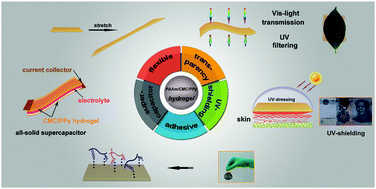A transparent and adhesive carboxymethyl cellulose/polypyrrole hydrogel electrode for flexible supercapacitors†
Abstract
Flexible supercapacitors have attracted increasing attention due to their unique soft and capacitive properties. However, for a conductive polymer-based electrode material, the mechanical properties, conductivity and the interface bonding with the electrolyte are all challenging. Here, polypyrrole (PPy) hydrogel electrodes with high stretchability (over 700%), electrical conductivity (11.07 S m−1) and interfacial bonding properties were prepared by doping carboxymethyl cellulose (CMC). Due to the emulsification effect of CMC, PPy could form hydrophilic CMC/PPy fibers in aqueous solutions. Moreover, during the formation process of the PPy hydrogel, uniformly distributed CMC/PPy particles were obtained in situ, resulting in the unique visible light transmission and ultraviolet shielding characteristics of the PPy hydrogel. As a flexible electrode, the PPy hydrogels were assembled into an all-solid-state supercapacitor, which exhibited a specific capacitance of 126.38 F g−1 and excellent cyclic stability (capacitance retention of 82% after 1000 cycles). This facile method of preparing transparent PPy hydrogels can pave a new way for constructing capacitive electronic skins.



 Please wait while we load your content...
Please wait while we load your content...